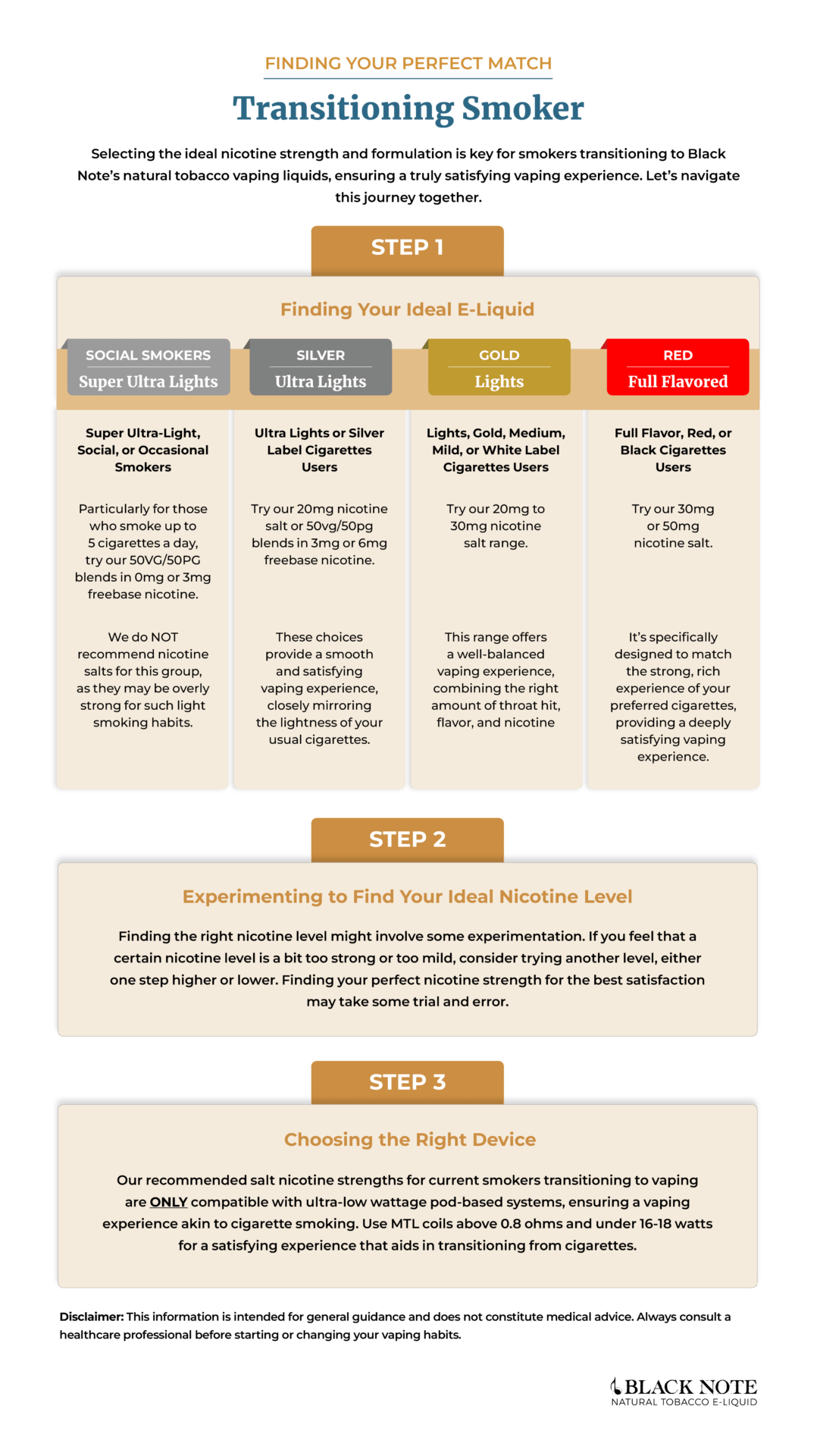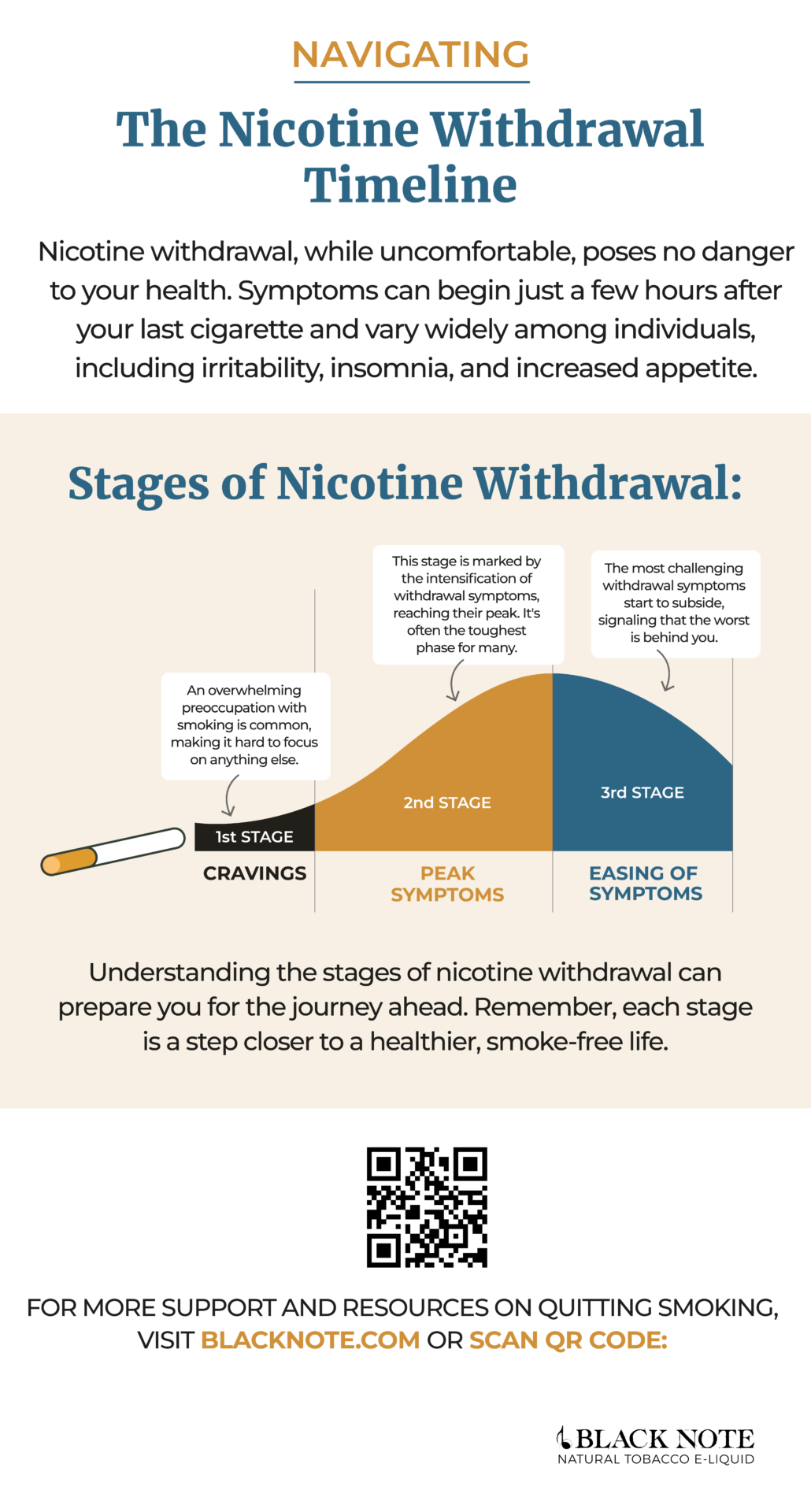Table of Contents
- Assessing Your Readiness to Quit
- Choosing Your Quit Strategy
- Overcoming Temptation
- Managing Cravings and Withdrawal Symptoms
- 10 Steps to Successfully Make a Plan to Quit Smoking
- Quick Tips to Quit
- Monitoring Progress and Staying Motivated
- Black Note: Your Trusted Partner in Quitting Smoking
- FAQ’s
- RECLAIM YOUR INDEPENDENCE: Are You Ready to Quit Smoking?
- Sources
- Disclaimer
Quitting smoking is a monumental step toward better health and well-being. This guide will provide a detailed roadmap to help you create a personalized quit smoking plan tailored to your needs. We’ll address common fears and insecurities, explain the importance of quitting, and provide actionable steps and resources to support your journey. By the end, you’ll be equipped with the knowledge and tools needed to reclaim your independence from smoking.
Smoking impacts your health, the well-being of those around you, and the environment. Despite understanding these dangers, the addictive nature of nicotine often makes quitting challenging. This blog aims to empower you with strategies and insights to help you overcome these challenges.
VAPE GUIDE
New to Vaping or Black Note?



Whether you're transitioning from smoking to vaping or seeking an upgrade to natural tobacco e-liquids, Black Note has you covered. Our quick, 15-second quiz and comprehensive guide are tailored to help both smokers and current vapers discover their ideal natural vaping alternatives.



Assessing Your Readiness to Quit
Assessing your readiness is a crucial first step in your quit journey. Understanding your motivation and preparing for the challenges ahead can significantly increase your chances of success. Understand the importance of self assesment:
Why Do You Want to Quit?
Knowing your reasons can strengthen your resolve and keep you motivated. Common reasons include:
- Improving Health: Quitting smoking reduces your risk of developing smoking-related illnesses like lung cancer, heart disease, and respiratory problems. Within just a few weeks of quitting, your lung function begins to improve, and your circulation gets better. Over time, your risk of severe health conditions continues to decrease.
- Protecting Loved Ones: Second-hand smoke is harmful to those around you, including your family, friends, and pets. By quitting, you reduce their exposure to these harmful chemicals and contribute to their overall well-being. Children and pets are especially vulnerable to second-hand smoke, which can cause respiratory issues and other health problems.
- Saving Money: Smoking is an expensive habit. By quitting, you can save a substantial amount of money that can be better spent on healthier activities, hobbies, or savings. Consider calculating the amount you spend on cigarettes each week, month, or year to see how much you could save by quitting.
What Are Your Smoking Triggers?
Identifying situations or emotions that prompt you to smoke can help you develop strategies to avoid or cope with these triggers. Common triggers include:
- Stress or Anxiety: Many people smoke to relieve stress. Identifying alternative stress-relief methods, such as exercise, meditation, or deep breathing exercises, can help you manage these triggers without smoking.
- Social Situations: Being around other smokers or socializing in environments where smoking is common can trigger cravings. Developing strategies to avoid these situations or finding supportive friends who don’t smoke can be beneficial.
- Routine and Habits: Certain times of day or activities, like having a coffee in the morning or taking breaks at work, may be associated with smoking. Changing your routine and finding new habits can help break these associations.
Are You Ready to Handle Withdrawal Symptoms?
Preparing for the physical and psychological effects of quitting, such as irritability, anxiety, and cravings, can help you manage them more effectively. Understanding what to expect can make the process less daunting.
- Physical Symptoms: These can include headaches, dizziness, increased appetite, and trouble sleeping. Knowing these are temporary and part of the healing process can help you stay committed.
- Psychological Symptoms: These include mood swings, depression, and difficulty concentrating. Having strategies in place to deal with these symptoms, such as mindfulness practices, support from loved ones, or professional counseling, can be very helpful.
Choosing Your Quit Strategy
Selecting the right quit strategy is essential for your success. Different methods work for different people, and finding the one that suits you best can make all the difference.
1. Cold Turkey
Quitting smoking “cold turkey” means stopping abruptly without any gradual reduction or the use of aids like nicotine replacement therapies (NRTs) or medications. This method relies solely on the individual’s willpower and determination to overcome the addiction.
How It Works:
- Immediate Cessation: You stop smoking entirely, which means no more cigarettes or nicotine intake from the moment you decide to quit.
- Withdrawal Management: You deal with the full range of withdrawal symptoms from nicotine addiction, including cravings, irritability, anxiety, and physical discomfort.
- Behavioral Changes: Since you are not using any aids, it’s crucial to implement significant behavioral changes to cope with the urge to smoke. This may include avoiding triggers, finding alternative activities, and seeking support from friends, family, or support groups.
Pros of Cold Turkey:
- Immediate Health Benefits: As soon as you stop smoking, your body begins to heal from the damage caused by smoking. Within hours, your carbon monoxide levels drop, and within days, your heart and lung functions start to improve.
- No Prolonged Nicotine Exposure: By quitting abruptly, you avoid prolonged exposure to nicotine, which can help break the addiction cycle more quickly.
- Simplicity: This method doesn’t require any special products, prescriptions, or gradual planning. It’s straightforward and free.
Cons of Cold Turkey:
- Intense Withdrawal Symptoms: Because there is no gradual reduction in nicotine intake, withdrawal symptoms can be severe. These may include strong cravings, mood swings, irritability, anxiety, headaches, and physical discomfort.
- Higher Relapse Rates: The intensity of withdrawal symptoms can make it challenging to stay committed, leading to a higher risk of relapse. Studies have shown that cold turkey has lower long-term success rates compared to other methods.
- Lack of Support: Without aids or structured support, managing the psychological and behavioral aspects of quitting can be difficult. Many people find it challenging to cope with the triggers and stress that lead to smoking.
Tips for Quitting Cold Turkey:
- Preparation: Plan your quit day and mentally prepare yourself for the challenges ahead. Clear your environment of cigarettes, lighters, and ashtrays.
- Support System: Inform friends and family about your decision to quit and seek their support. Joining a support group or online community can also provide motivation and encouragement.
- Healthy Alternatives: Find healthy ways to manage stress and keep your hands and mouth busy, such as exercising, chewing gum, or engaging in hobbies.
- Stay Positive: Remind yourself of the reasons you’re quitting and the benefits you will gain. Celebrate small victories and milestones along the way.
Understand more about The Smoke Free Revolution: Understanding Nicotine and Better Choices for Adult Smokers
2. Gradual Reduction
Gradual reduction involves slowly decreasing the number of cigarettes you smoke over time until you quit completely. This method helps to reduce nicotine dependence gradually, making the transition smoother.
How It Works:
- Set a Reduction Schedule: Create a plan to reduce your daily cigarette intake over weeks or months.
- Monitor Progress: Keep track of the number of cigarettes you smoke each day and gradually decrease this number.
- Behavioral Adjustments: Begin to replace smoking times with healthier activities and develop coping mechanisms for triggers.
Pros of Gradual Reduction:
- Eases Withdrawal Symptoms: By reducing nicotine intake slowly, the intensity of withdrawal symptoms can be lessened, making it easier to manage cravings and discomfort.
- Adjustable Pace: You can set a pace that suits your comfort level, adjusting the reduction rate based on how your body responds.
- Behavioral Transition: Allows time to build and reinforce new, healthy habits to replace smoking.
Cons of Gradual Reduction:
- Prolonged Exposure: You continue to expose yourself to nicotine and harmful chemicals in cigarettes for a longer period.
- Requires Discipline: Consistently reducing the number of cigarettes can be challenging, and there’s a risk of not sticking to the plan.
- Potential for Relapse: The slower process may increase the temptation to revert to higher smoking levels, especially during stressful periods.
Tips for Gradual Reduction:
- Set Clear Goals: Define specific targets for daily cigarette reduction and establish a final quit date.
- Track Progress: Use a journal or app to monitor your smoking habits and reduction milestones.
- Find Alternatives: Identify and engage in activities that distract you from smoking, such as exercising, hobbies, or socializing.
- Seek Support: Inform friends, family, or join a support group to stay motivated and accountable.
3. Nicotine Replacement Therapy (NRT)
Nicotine Replacement Therapy (NRT) involves using products that provide low doses of nicotine to reduce withdrawal symptoms and cravings, without the harmful chemicals found in cigarettes.
How It Works:
- Product Options: NRT includes nicotine gum, patches, lozenges, inhalers, and nasal sprays. Each product delivers nicotine in controlled amounts.
- Usage Plan: Follow the recommended dosage and schedule for the chosen NRT product. Gradually decrease the dose over time.
- Combination: Some people use a combination of NRT products for better control over cravings.
Pros of NRT:
- Reduces Withdrawal Symptoms: NRT provides a controlled dose of nicotine, helping to manage cravings and withdrawal symptoms effectively.
- Increases Success Rates: Studies show that using NRT can double the chances of successfully quitting smoking.
- Flexible Options: A variety of NRT products are available, allowing individuals to choose the method that best fits their lifestyle and preferences.
Cons of NRT:
- Requires Proper Usage: Effectiveness depends on using the correct dosage and following the recommended schedule.
- Side Effects: Some users may experience side effects such as skin irritation (patches), mouth irritation (gum), or nausea.
- Dependency Risk: There’s a potential risk of becoming dependent on NRT products, though they are safer than smoking.
Tips for Using NRT:
- Choose the Right Product: Consult with a healthcare provider to select the most suitable NRT product based on your smoking habits and health condition.
- Follow Instructions: Adhere to the recommended dosage and usage guidelines to maximize the effectiveness of NRT.
- Combine with Behavioral Support: Use NRT in conjunction with behavioral therapy or support groups for better results.
- Gradually Reduce Dosage: Over time, reduce the dosage of NRT to wean yourself off nicotine completely.


4. Prescription Medications: Pharmacological Support for Quitting Smoking
Prescription Medications Defined: Prescription medications for quitting smoking are drugs prescribed by a doctor to help reduce cravings and withdrawal symptoms. Common medications include varenicline (Chantix) and bupropion (Zyban).
How It Works:
- Medical Consultation: Consult with a healthcare provider to determine if prescription medications are suitable for you.
- Medication Plan: Follow the prescribed dosage and schedule for the medication.
- Duration: Typically, these medications are taken for a set period, often 12 weeks, with a gradual reduction towards the end.
Pros of Prescription Medications:
- Effective Craving Reduction: These medications can significantly reduce cravings and withdrawal symptoms.
- Behavioral Support: They often provide additional behavioral support by targeting nicotine receptors in the brain.
- Combination with Other Methods: Can be used alongside NRT or behavioral therapy for a comprehensive approach.
Cons of Prescription Medications:
- Side Effects: Potential side effects include nausea, insomnia, vivid dreams, and mood changes. It’s important to monitor and report any adverse effects to your doctor.
- Medical Supervision Required: Regular check-ins with a healthcare provider are necessary to monitor progress and manage side effects.
- Not Suitable for Everyone: Certain medical conditions or medications may contraindicate the use of these drugs.
Tips for Using Prescription Medications:
- Consult Your Doctor: Always start with a medical consultation to ensure the medication is appropriate for you.
- Follow the Prescription: Adhere to the prescribed dosage and schedule to ensure effectiveness.
- Monitor Side Effects: Keep track of any side effects and communicate them to your healthcare provider.
- Combine with Support: Use in conjunction with behavioral support or therapy to enhance your chances of quitting.
5. Behavioral Therapy: Changing Smoking Behaviors
Behavioral Therapy Defined: Behavioral therapy involves working with a therapist to change smoking behaviors and develop coping strategies. It focuses on identifying triggers, creating new habits, and building a support system.
How It Works:
- Therapy Sessions: Engage in regular sessions with a therapist trained in smoking cessation.
- Behavioral Techniques: Learn and practice techniques to manage cravings, avoid triggers, and handle stress without smoking.
- Support System: Build a network of support, including friends, family, and support groups.
Pros of Behavioral Therapy:
- Personalized Support: Therapy provides individualized support and strategies tailored to your specific needs and challenges.
- Long-Term Success: By addressing the psychological aspects of addiction, behavioral therapy can lead to long-term success in quitting smoking.
- Emotional Support: Therapy offers emotional support, helping you to manage stress and anxiety that may lead to smoking.
Cons of Behavioral Therapy:
- Time Commitment: Requires a significant time commitment for regular therapy sessions.
- Cost: Therapy can be expensive, and not all insurance plans cover smoking cessation programs.
- Access to Qualified Therapists: Finding a qualified therapist with experience in smoking cessation can be challenging in some areas.
Tips for Behavioral Therapy:
- Find a Qualified Therapist: Look for therapists with specific training and experience in smoking cessation.
- Commit to the Process: Be prepared to invest time and effort into therapy sessions and homework assignments.
- Build a Support Network: In addition to therapy, seek support from friends, family, and support groups to reinforce your quit plan.
- Practice New Behaviors: Actively practice the new behaviors and coping strategies learned in therapy.
Quitting smoking is a journey, not a destination. Every step forward, no matter how small, is a victory.
Overcoming Temptation
Dealing with nicotine addiction is challenging, and many people have specific triggers that prompt them to smoke. These triggers are behaviors or situations associated with smoking that can set off the psychological desire to light up. Recognizing your triggers is the first step. Common triggers include:
- Drinking Coffee or Tea: For many, a cigarette goes hand-in-hand with a morning coffee or tea. The habit is often ingrained and associated with the routine of starting the day. Switching to a different beverage or altering your morning routine can help disrupt this association.
- Drinking Alcohol: Alcohol can lower inhibitions and make it harder to resist the urge to smoke. Consider reducing alcohol consumption, avoiding situations where you drink, or choosing non-smoking environments.
- Driving or Being in the Car: The act of driving or being in the car is a common trigger, especially for those who smoked during long commutes. Keep your car smoke-free, have healthy snacks or gum available, and find new activities to occupy your time while driving.
- Working or Thinking: Stressful work situations or deep thinking can prompt smoking as a way to take a break or relieve stress. Try substituting with quick exercises, deep breathing, or short walks.
- Watching TV: Sitting down to watch TV often includes smoking for many individuals. Keep your hands busy with a stress ball, knitting, or other hobbies.
- Seeing Other People Smoke: Watching others smoke can trigger cravings. Avoid places where smoking is common, and spend time with non-smokers who can support your quit journey.
- After Eating or Sex: These are common times when smokers light up. Plan an alternative activity after meals, like brushing your teeth or chewing gum, and find new ways to relax after sex.
- Feeling Nervous, Anxious, or Angry: Emotional states can be powerful triggers. Practice mindfulness, meditation, or engage in physical activity to manage stress and emotions without smoking.
- Pondering a Problem: Deep thinking or problem-solving can make you reach for a cigarette. Break the pattern by taking breaks, walking, or doing a different mental task.
- Socializing with Other Smokers: Being around others who smoke can be challenging. Let your friends know about your quit plan and ask for their support, or avoid social gatherings where smoking is prevalent.
- Relaxing or Taking a Break: Many people smoke to relax. Replace smoking breaks with activities that can help you unwind, like stretching, deep breathing, or listening to music.
Developing Strategies to Cope with Triggers:
- Identify Triggers: Keep a journal of your smoking habits to identify patterns and specific triggers.
- Avoid Triggers: Where possible, avoid situations that trigger the urge to smoke.
- Substitute Behaviors: Replace smoking with healthier habits, such as chewing gum, drinking water, or taking a walk.
- Find Distractions: Engage in activities that keep your hands and mind busy, like hobbies, exercise, or socializing with non-smokers.
- Develop a Support Network: Seek support from friends, family, or join a support group to help manage cravings and stay motivated.
- Practice Mindfulness: Techniques such as deep breathing, meditation, or yoga can help manage stress and reduce the urge to smoke.
- Reward Yourself: Celebrate milestones and successes, no matter how small, to stay motivated and remind yourself of the progress you’ve made.
PREMIUM TOBACCO E-LIQUIDS
Authentic Flavors, Unmatched Quality



Step into Black Note's world and explore a premium selection of natural tobacco e-liquids. Crafted for the discerning smoker and vaper.



Managing Cravings and Withdrawal Symptoms
Withdrawal symptoms are a natural part of quitting smoking. Understanding and preparing for these symptoms can help you manage them effectively. Here’s an expanded look at common withdrawal symptoms and tips for managing cravings.
When you quit smoking, your body begins to adjust to the absence of nicotine, which leads to withdrawal symptoms. These symptoms can be both physical and psychological and are your body’s way of reacting to the lack of nicotine it has become dependent on. Preparing for and understanding these symptoms can make the quitting process more manageable.
Common Withdrawal Symptoms:
1. Irritability:
You may feel easily annoyed or frustrated. This irritability is a common response to nicotine withdrawal as your body adapts to functioning without it.
- Why it Happens: Nicotine stimulates the release of dopamine, a chemical in the brain that affects mood. Without nicotine, dopamine levels drop, leading to irritability.
- Managing It: Practice deep breathing exercises, engage in physical activities, or find calming activities that can help alleviate irritability.
2. Anxiety:
Increased feelings of nervousness or anxiety are typical as your body adjusts to the absence of nicotine.
- Why it Happens: Nicotine can have a calming effect, so without it, you might experience heightened anxiety.
- Managing It: Techniques such as mindfulness meditation, yoga, or talking to a friend or therapist can help manage anxiety levels.
3. Cravings:
Intense urges to smoke are frequent and can be very strong, especially in the first few weeks after quitting.
- Why it Happens: Your body craves nicotine to restore the feeling of pleasure and relief it used to get from smoking.
- Managing It: Distract yourself with activities or hobbies, chew gum or eat healthy snacks, and use nicotine replacement therapies (NRTs) to ease the cravings.
Tips for Managing Cravings:
- Distract Yourself with Activities or Hobbies: Engaging in activities you enjoy can take your mind off cravings. Whether it’s reading a book, gardening, or playing a sport, keeping busy can help reduce the urge to smoke. Start a new hobby, exercise, play games, or spend time with friends and family.
- Chew Gum or Eat Healthy Snacks: Keeping your mouth busy can alleviate the oral fixation associated with smoking. Sugar-free gum, crunchy vegetables, or fruits are good options that can also help you manage weight gain concerns. Try Carrot sticks, celery, nuts, or whole grain snacks can keep your hands and mouth busy.
- Use Nicotine Replacement Therapies (NRTs): Products like nicotine gum, patches, lozenges, inhalers, or nasal sprays can help manage cravings and withdrawal symptoms by providing controlled doses of nicotine. These therapies can ease the transition by reducing the intensity of cravings. Choose the form of NRT that best fits your lifestyle and needs. For example, patches provide a steady dose of nicotine throughout the day, while gum and lozenges can be used on demand.
Additional Strategies for Managing Cravings:
- Practice Deep Breathing and Relaxation Techniques: Deep breathing exercises can help calm your mind and reduce anxiety. Techniques such as progressive muscle relaxation or mindfulness meditation can also be effective. Try deep breathing exercises like inhaling deeply through your nose, holding for a few seconds, and exhaling slowly through your mouth.
- Stay Hydrated: Drinking plenty of water can help flush nicotine and other chemicals out of your system. Staying hydrated can also help reduce cravings and improve your overall well-being. Hydration aids in detoxifying your body and can curb the sensation of hunger, which can be mistaken for nicotine cravings.
- Physical Activity: Exercise can help reduce cravings by releasing endorphins, which are natural mood enhancers. Even a short walk can make a significant difference in managing withdrawal symptoms. Engage in regular physical activity such as walking, jogging, cycling, or yoga.
- Create a Support System: Surround yourself with supportive friends, family, or join a support group. Sharing your experiences and challenges with others who understand can provide emotional support and encouragement. Online forums, local support groups, or counseling can provide additional support and motivation.
- Avoid Triggers: Identify situations, people, or activities that trigger the urge to smoke and develop strategies to avoid or cope with these triggers. For example, if you usually smoke while drinking coffee, switch to tea or change your routine. Change your routine, avoid places where people smoke, and stay away from stressful situations when possible.
- Reward Yourself: Celebrate small milestones and successes along your quit journey. Rewards can be a powerful motivator to stay on track and remind you of the benefits of quitting smoking. Treat yourself to something special, like a new book, a movie, or a relaxing activity, for reaching milestones.
Recommended Reading: For more detailed guidance on Quitting Timeline read Nicotine Withdrawal Guideline.
10 Steps to Successfully Make a Plan to Quit Smoking
Creating a detailed plan increases your chances of success. Here are ten steps to help you quit smoking:
- Set a Quit Date: Choose a strategic date to quit. Consider significant days that can serve as motivation, such as birthdays or anniversaries. Mark it on your calendar and mentally prepare for the change.
- Identify Triggers: Track when and why you smoke. Keep a diary of your smoking habits to identify patterns and triggers. This will help you understand what situations or emotions lead you to smoke.
- Beat Your Triggers: Develop strategies to avoid or cope with triggers. For example, if you smoke while drinking coffee, switch to tea or change your routine to break the association. Substitute smoking with healthier activities like taking a walk or chewing gum.
- Get Smart About Your Smoking Addiction: Educate yourself on the addiction. Understanding how nicotine affects your body and mind can empower you to overcome it. Research the health benefits of quitting and remind yourself of these benefits regularly.
- Choose a Quit Smoking Aid: Select the right tools to help you quit. Whether it’s NRT, prescription medications, or support groups, choose aids that fit your needs. Consult with a healthcare provider to determine the best options for you.
- Tell Someone, Anyone: Inform others of your plan for support. Having friends, family, or colleagues aware of your goal can provide encouragement and accountability. Join online forums or local support groups to share your journey with others who are also quitting.
- Out with the Old and In with the New: Remove smoking-related items and adopt new habits. Clear your home, car, and workplace of cigarettes, lighters, and ashtrays. Replace them with healthy snacks, water, and stress-relief tools like stress balls or fidget spinners.
- Get Ready, Get Set: Prepare yourself mentally and physically. Engage in activities that promote well-being, such as exercise, meditation, and hobbies. These activities can help reduce stress and keep your mind off smoking.
- Go: Take the plunge and quit. Stay committed to your quit date and use your support network and resources to stay on track. Follow your plan, use your chosen aids, and keep reminding yourself of your reasons for quitting.
- Pick Yourself Back Up if Needed: Don’t be discouraged by setbacks. If you relapse, analyze what went wrong, learn from it, and try again. Remember, many people need several attempts to quit successfully. Stay positive and keep trying.
Quick Tips to Quit
Seek Support from Family and Friends:
Let your loved ones know about your plan to quit and ask for their support. They can provide encouragement, help you stay accountable, and be there to talk you through difficult moments.
Use Tools and Medications to Help Wean Off Nicotine:
Utilize NRT products like patches, gum, or lozenges, or consider prescription medications to manage withdrawal symptoms and reduce cravings. These aids can significantly increase your chances of quitting successfully.
Establish a Plan and Stick to It:
Create a detailed quit plan that includes your quit date, strategies for managing triggers, and a list of support resources. Follow your plan diligently and make adjustments as needed to stay on track.
Celebrate each milestone on your quit journey—every smoke-free day is a step closer to a healthier you.
Monitoring Progress and Staying Motivated
Tracking your progress and celebrating milestones can keep you motivated throughout your quit journey. Here’s how:
Keep a Journal: Documenting your journey helps you reflect on your experiences, identify patterns, and recognize progress. Write down your daily progress, challenges, and victories. This can provide insight into your triggers and help you develop strategies to manage them. Journaling also offers a therapeutic outlet to express your emotions and thoughts during the quitting process.
Reward Yourself: Celebrate achievements with rewards that don’t involve smoking. Treat yourself to something special when you reach significant milestones, such as a month without smoking or successfully navigating a challenging situation without lighting up. Rewards can be small, like a favorite treat or a movie night, or larger, like a spa day or a weekend getaway. Celebrating your successes reinforces positive behavior and motivates you to continue.
Reflect on Your Reasons for Quitting: Remind yourself why you started this journey. Keep a list of your reasons for quitting and refer to it whenever you feel tempted. Whether it’s improving your health, protecting your loved ones, or saving money, revisiting these reasons can strengthen your resolve and keep you focused on your goal. Visual reminders, such as photos of loved ones or a list of health benefits, can also be powerful motivators.
Black Note: Your Trusted Partner in Quitting Smoking
At Black Note, our mission is to help users quit smoking. We’re in business to go out of business by promoting vaping as a cessation tool against traditional smoking. Our products are designed to support your quit journey and make the transition smoother.
We believe in providing high-quality, natural vaping products that can help you reduce your dependence on nicotine and eventually quit smoking altogether. Our commitment to excellence and customer satisfaction sets us apart as a trusted partner in your quit journey.
Black Note stands as a pinnacle in the vaping industry, dedicated to helping people quit smoking. Our premium vaping products are crafted with natural ingredients, free from harmful additives, ensuring a safer alternative to traditional cigarettes. We understand that quitting smoking is a challenging process, and we strive to offer comprehensive support in any way or form.
FAQ’s
How can I prepare to quit smoking?
Preparation involves setting a quit date, identifying your triggers, and developing a plan. Informing friends and family for support, and removing smoking-related items from your environment can also help. Consider using resources like support groups or counseling to strengthen your quit strategy.
What should I do if I have a craving?
Cravings are a natural part of quitting. Distract yourself with activities, drink water, practice deep breathing, or use nicotine replacement therapies (NRTs). Remind yourself of your reasons for quitting and keep a list of strategies handy for managing cravings.
How can I manage withdrawal symptoms?
Managing withdrawal involves staying hydrated, engaging in physical activity, practicing relaxation techniques, and using NRTs or medications as prescribed. It’s important to have a support system and access resources like counseling or quitlines.
What if I relapse and smoke again?
Relapse is common and should be seen as a learning opportunity. Analyze what triggered the relapse, adjust your quit plan, and try again. Many people need multiple attempts to quit successfully. Stay positive and seek support from loved ones or professional resources.
Are there medications that can help me quit smoking?
Yes, there are prescription medications such as varenicline (Chantix) and bupropion (Zyban) that can help reduce cravings and withdrawal symptoms. Consult with your healthcare provider to determine which medication might be suitable for you.
How can I handle stress without smoking?
Handling stress without smoking can involve adopting healthy stress-relief activities such as exercise, meditation, deep breathing exercises, and engaging in hobbies. Building a support network and seeking professional counseling can also be beneficial.
What support is available to help me quit?
Support options include counseling, support groups, quitlines, online resources, and mobile apps. Professional guidance from healthcare providers can also offer personalized advice and strategies to help you quit smoking.
Is it possible to quit smoking without gaining weight?
Yes, it is possible. Focus on maintaining a healthy diet, staying active, and using strategies to manage cravings without turning to food. Drinking plenty of water and engaging in regular physical activity can help manage weight during the quit process.
Can e-cigarettes help me quit smoking?
E-cigarettes can be a tool to help some people quit smoking by providing a less harmful alternative to traditional cigarettes. However, it’s important to use them as part of a comprehensive quit plan. Consult with your healthcare provider to see if e-cigarettes are appropriate for you.
RECLAIM YOUR INDEPENDENCE: Are You Ready to Quit Smoking?
You know smoking is harmful to your health, the environment, and even puts your loved ones at risk through second-hand smoke. Yet, quitting isn’t easy because nicotine is a highly addictive substance. Being aware of the dangers is essential, but sometimes knowledge alone isn’t enough to break the habit. This section is about understanding why quitting is challenging and how you can reclaim your independence from smoking.
By recognizing the power nicotine holds over you, you can begin to take steps to break free. This blog provides you with valuable information, resources, and even a story contest to inspire and support you on your quit journey.

Sources
- http://www.lung.org/stop-smoking/
- https://smokefree.gov/
- https://www.cancer.org/healthy/stay-away-from-tobacco/guide-quitting-smoking.html
- https://quitday.org/smoking-effects/smoking-addiction-mental-vs-physical-addiction/
- http://www.newhealthguide.org/How-Long-Does-It-Take-For-Nicotine-To-Completely-Leave-The-Body.html
- http://www.scientificpsychic.com/health/smoking-psychology.html
- https://veterans.smokefree.gov/build-your-quit-plan
- https://smokefree.gov/build-your-quit-plan
- https://www.cancer.org/cancer/risk-prevention/tobacco/guide-quitting-smoking/deciding-to-quit-smoking-and-making-a-plan.html
Disclaimer
The information provided in this blog post is for educational and informational purposes only. This information is not intended as health or medical advice. Always consult a physician or other qualified health provider regarding any questions you may have about a medical condition or health objectives.
The views and opinions expressed in this blog are those of the author and do not necessarily reflect the official policy or position of any other agency, organization, employer, or company, including Black Note and its affiliates. The author, who is not a medical professional, writes this blog post without intending to offer medical advice or replace advice or treatment from a personal physician.
This blog post discusses tobacco products, e-cigarettes, and related substances, intended solely for adult use and potentially harmful to health. We advise all readers/users of this content to quit smoking and/or vaping, or to consult a doctor before starting or continuing to smoke and/or vape.
The author, the blog, Black Note, and its affiliates assume no responsibility for any actions or inaction a reader takes based on the information presented in this blog. We do not intend this content to promote smoking or vaping, and readers should interpret it accordingly.









